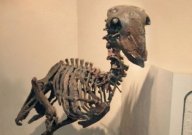Palaeontology
November 25, 2012 · 5 comments
5 comments

Image Credit: CC 3.0 Postdlf
The revelation was made following the discovery of footprints from the species that showed no signs of raptor-like claws or other features you would expect to find in a carnivore. "[The tracks] clearly show that the animals did not have long talons, but rather short toenails," said David Tucker from Western Washington University. "This argues against an animal that catches prey and uses claws to hold it down. Carnivorous birds all have sharp, long talons."[!gad]With a huge beak and standing at up to 7ft in height, Diatryma had long been considered to be a dangerous, meat-eating scavenger that nobody in their right mind would ever want to mess with. Sometimes referred to as being "the bird that replaced dinosaurs as the top predator", it turns out that far from being a flesh-eating monster Diatryma was actually a gentle herbivore that would have only eaten plants.
The revelation was made following the discovery of footprints from the species that showed no signs of raptor-like claws or other features you would expect to find in a carnivore. "[The tracks] clearly show that the animals did not have long talons, but rather short toenails," said David Tucker from Western Washington University. "This argues against an animal that catches prey and uses claws to hold it down. Carnivorous birds all have sharp, long talons."
Source: BBC News | Comments (5)
Giant prehistoric bird was 'gentle herbivore'
By T.K. RandallNovember 25, 2012 ·
 5 comments
5 comments
Image Credit: CC 3.0 Postdlf
Despite it's size and fierce looks the giant bird Diatryma may not have been a carnivore after all.
With a huge beak and standing at up to 7ft in height, Diatryma had long been considered to be a dangerous, meat-eating scavenger that nobody in their right mind would ever want to mess with. Sometimes referred to as being "the bird that replaced dinosaurs as the top predator", it turns out that far from being a flesh-eating monster Diatryma was actually a gentle herbivore that would have only eaten plants.The revelation was made following the discovery of footprints from the species that showed no signs of raptor-like claws or other features you would expect to find in a carnivore. "[The tracks] clearly show that the animals did not have long talons, but rather short toenails," said David Tucker from Western Washington University. "This argues against an animal that catches prey and uses claws to hold it down. Carnivorous birds all have sharp, long talons."[!gad]With a huge beak and standing at up to 7ft in height, Diatryma had long been considered to be a dangerous, meat-eating scavenger that nobody in their right mind would ever want to mess with. Sometimes referred to as being "the bird that replaced dinosaurs as the top predator", it turns out that far from being a flesh-eating monster Diatryma was actually a gentle herbivore that would have only eaten plants.
The revelation was made following the discovery of footprints from the species that showed no signs of raptor-like claws or other features you would expect to find in a carnivore. "[The tracks] clearly show that the animals did not have long talons, but rather short toenails," said David Tucker from Western Washington University. "This argues against an animal that catches prey and uses claws to hold it down. Carnivorous birds all have sharp, long talons."
Footprints believed to have been made by the giant bird Diatryma indicate that it was a "gentle herbivore" and not a fierce carnivore, scientists say.
Source: BBC News | Comments (5)

The Unexplained Mysteries
Book of Weird News
AVAILABLE NOW
Take a walk on the weird side with this compilation of some of the weirdest stories ever to grace the pages of a newspaper.
Click here to learn more

Support us on Patreon
BONUS CONTENTFor less than the cost of a cup of coffee, you can gain access to a wide range of exclusive perks including our popular 'Lost Ghost Stories' series.
Click here to learn more
Extraterrestrial Life and The UFO Phenomenon
Natural World
Israel, Palestine and the Middle-East
Science and Technology
Total Posts: 7,780,056 Topics: 325,672 Members: 203,953
Not a member yet ? Click here to join - registration is free and only takes a moment!
Not a member yet ? Click here to join - registration is free and only takes a moment!




























Please Login or Register to post a comment.